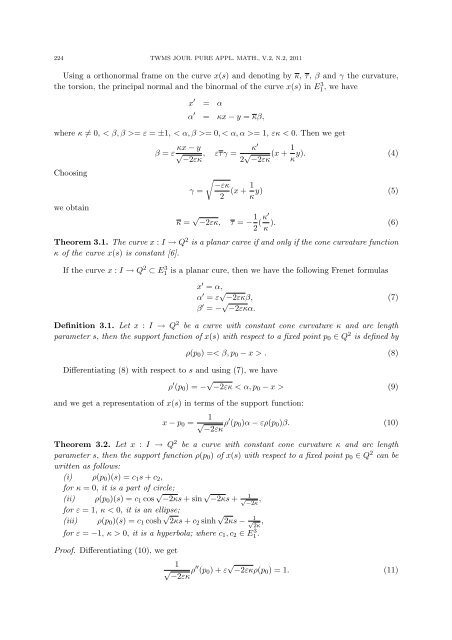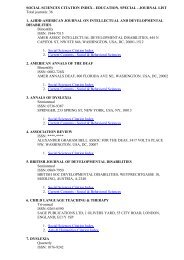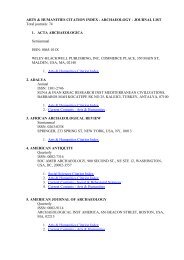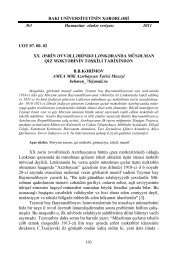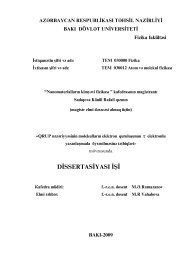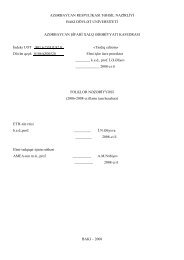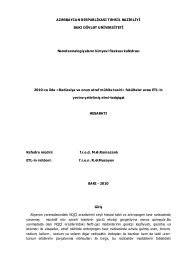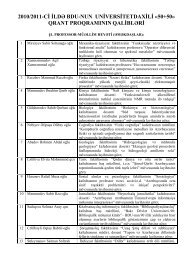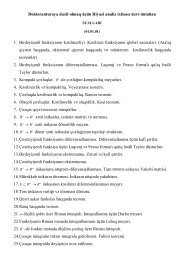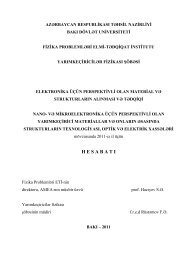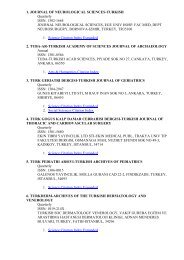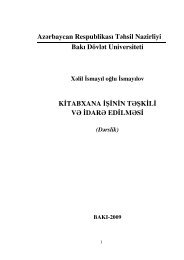ON CURVES IN THE LIGHTLIKE CONE 1. Introduction Lorentzian ...
ON CURVES IN THE LIGHTLIKE CONE 1. Introduction Lorentzian ...
ON CURVES IN THE LIGHTLIKE CONE 1. Introduction Lorentzian ...
You also want an ePaper? Increase the reach of your titles
YUMPU automatically turns print PDFs into web optimized ePapers that Google loves.
224 TWMS JOUR. PURE APPL. MATH., V.2, N.2, 2011Using a orthonormal frame on the curve x(s) and denoting by κ, τ, β and γ the curvature,the torsion, the principal normal and the binormal of the curve x(s) in E1 3 , we havex ′ = αα ′ = κx − y = κβ,where κ ≠ 0, < β, β >= ε = ±1, < α, β >= 0, < α, α >= 1, εκ < 0. Then we getChoosingwe obtainβ = ε κx − y √ −2εκ, ετγ =γ =κ = √ −2εκ,κ ′2 √ −2εκ (x + 1 y). (4)κ√−εκ2 (x + 1 y) (5)κτ = − 1 2 (κ′ ). (6)κTheorem 3.<strong>1.</strong> The curve x : I → Q 2 is a planar curve if and only if the cone curvature functionκ of the curve x(s) is constant [6].If the curve x : I → Q 2 ⊂ E 3 1is a planar cure, then we have the following Frenet formulasx ′ = α,α ′ = ε √ −2εκβ,β ′ = − √ −2εκα.(7)Definition 3.<strong>1.</strong> Let x : I → Q 2 be a curve with constant cone curvature κ and arc lengthparameter s, then the support function of x(s) with respect to a fixed point p 0 ∈ Q 2 is defined byDifferentiating (8) with respect to s and using (7), we haveρ(p 0 ) =< β, p 0 − x > . (8)ρ ′ (p 0 ) = − √ −2εκ < α, p 0 − x > (9)and we get a representation of x(s) in terms of the support function:x − p 0 =1√ −2εκρ ′ (p 0 )α − ερ(p 0 )β. (10)Theorem 3.2. Let x : I → Q 2 be a curve with constant cone curvature κ and arc lengthparameter s, then the support function ρ(p 0 ) of x(s) with respect to a fixed point p 0 ∈ Q 2 can bewritten as follows:(i) ρ(p 0 )(s) = c 1 s + c 2 ,for κ = 0, it is a part of circle;(ii) ρ(p 0 )(s) = c 1 cos √ −2κs + sin √ −2κs + √ 1−2κ,for ε = 1, κ < 0, it is an ellipse;(iii) ρ(p 0 )(s) = c 1 cosh √ 2κs + c 2 sinh √ 2κs − √ 12κ,for ε = −1, κ > 0, it is a hyperbola; where c 1 , c 2 ∈ E 3 1 .Proof. Differentiating (10), we get1√ −2εκρ ′′ (p 0 ) + ε √ −2εκρ(p 0 ) = <strong>1.</strong> (11)


